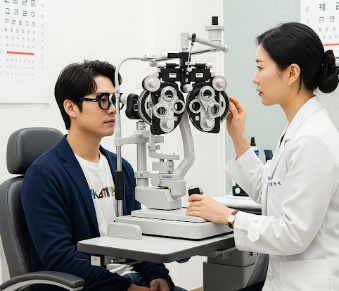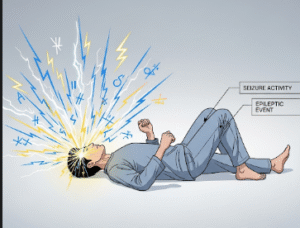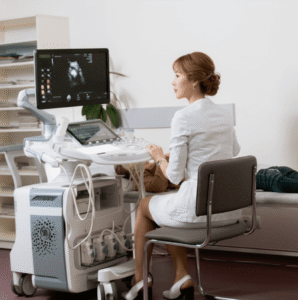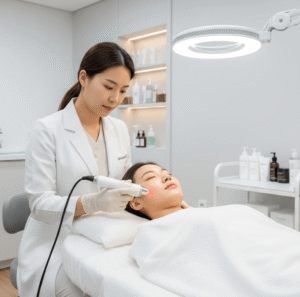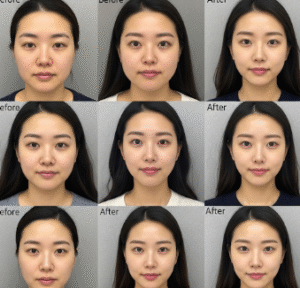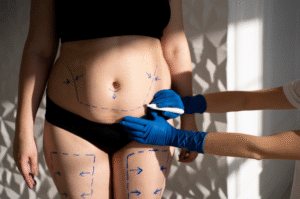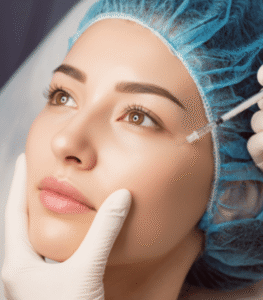Overview
Eye tests are a series of diagnostic examinations performed to evaluate vision clarity, eye health, and visual function. These tests are essential for detecting refractive errors, eye diseases, and conditions that may affect vision, such as glaucoma, cataracts, or retinal disorders.
In South Korea, eye tests are performed in advanced ophthalmology centers and eye hospitals, using modern imaging technologies, automated devices, and experienced ophthalmologists. Korean eye clinics are renowned for their accuracy, efficiency, and comprehensive care, making them a top choice for routine or specialized eye examinations.
What is an Eye Test?
An eye test, also known as an eye examination or vision test, involves a series of assessments designed to measure visual acuity, eye structure, and overall eye health.
Eye tests are usually recommended for:
- Routine vision screening → adults and children for glasses or contact lenses
- Symptoms of vision problems → blurred vision, double vision, or difficulty focusing
- Monitoring chronic conditions → diabetes, hypertension, or glaucoma
- Prevention → early detection of cataracts, retinal issues, or macular degeneration
These tests provide crucial information for prescribing corrective lenses, planning treatments, or diagnosing eye diseases.
What are the benefits?
Eye tests offer several advantages:
- Early detection of eye conditions → prevents progression of glaucoma, cataracts, and retinal disorders
- ➤ Accurate vision correction → ensures proper prescription for glasses or contact lenses
- ➤ Monitors eye health → identifies systemic conditions affecting vision
- ➤ Supports preventive care → reduces risk of permanent vision loss
- ➤ Comprehensive testing in Korea → advanced diagnostic equipment ensures precise results
- ➤ Child and adult-friendly examinations → suitable for all age groups
Procedure Details
1) How should I prepare for Eye Tests?
Proper preparation ensures accurate results:
- Bring previous prescriptions or eye records
- List current medications → some may affect vision or eye pressure
- Avoid wearing contact lenses on the day of certain tests (as advised by the ophthalmologist)
- Arrive well-rested → fatigue can affect visual acuity tests
- Discuss symptoms → provide detailed information to guide the ophthalmologist
2) What happens during the procedure Eye Tests?
Eye tests may include a combination of assessments, typically lasting 30–60 minutes:
- Visual acuity test → using a Snellen chart or digital screen to measure clarity of vision
- Refraction test → determines the correct prescription for glasses or contacts
- Eye pressure measurement (tonometry) → screens for glaucoma
- Slit-lamp examination → assesses anterior eye structures such as cornea, iris, and lens
- Retinal examination → using ophthalmoscopy or fundus photography to evaluate retina and optic nerve
- Color vision and depth perception tests → evaluates visual function and deficiencies
- Additional tests → OCT (Optical Coherence Tomography), visual field tests, or corneal topography if indicated
In Korea, ophthalmologists utilize state-of-the-art imaging and diagnostic tools to ensure highly accurate assessments for both routine and specialized eye care.
3) What happens after an Eye Test?
- Immediate feedback → prescription for glasses or contacts if needed
- Referral → further evaluation or treatment if an eye disease is detected
- Follow-up → periodic checkups for chronic eye conditions
- Patient education → guidance on eye care, preventive measures, and lifestyle adjustments
- Long-term outlook → regular eye testing helps maintain optimal vision and early disease detection
Risks / Benefits
Potential Risks:
- Minor temporary eye strain after prolonged testing
- Dilated pupil discomfort → sensitivity to light for a few hours
- Rare complications → minor irritation from eye drops or contact lenses used during testing
Key Benefits:
- Comprehensive evaluation of vision and eye health
- ➤ Early detection of serious eye diseases
- ➤ Accurate prescription for corrective lenses
- ➤ Monitoring systemic health conditions affecting the eyes
- ➤ Access to advanced diagnostic technology in Korea
Recovery and Outlook
- Immediate recovery → most tests are non-invasive and patients resume normal activities immediately
- Short-term effects → mild light sensitivity if pupils were dilated
- Functional improvement → better vision correction and management of eye conditions
- Long-term outcome → regular eye testing ensures preservation of vision, early treatment of eye diseases, and improved quality of life
- In Korea, patients benefit from advanced ophthalmologic care, precise diagnostics, and expert follow-up
When To Call the Doctor
Contact your ophthalmologist if you experience:
- Sudden changes in vision → blurred vision, floaters, or flashes of light
- ➤ Eye pain, redness, or swelling
- ➤ Persistent double vision or difficulty focusing
- ➤ Visual disturbances following eye tests or eye drops
- ➤ Headaches or eye strain beyond expected post-examination effects
Early evaluation ensures timely intervention and protection of vision.
Best Korea Option / Process
South Korea offers world-class eye testing and ophthalmology services:
- Expert ophthalmologists → skilled in diagnostics and comprehensive eye care
- Advanced imaging and diagnostic tools → OCT, fundus photography, tonometry, and more
- Comprehensive care packages → evaluation, testing, prescription, and follow-up
- Child and adult-friendly clinics → accommodating patients of all ages
- International patient support → multilingual staff, appointments, and personalized care
Patients choosing Korea for eye tests can expect precise, thorough, and patient-centered evaluation, making it a top destination for ophthalmologic care in Asia.

